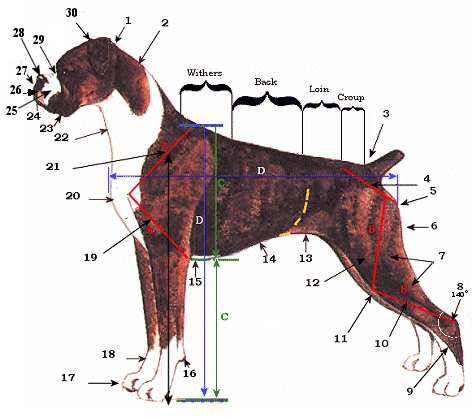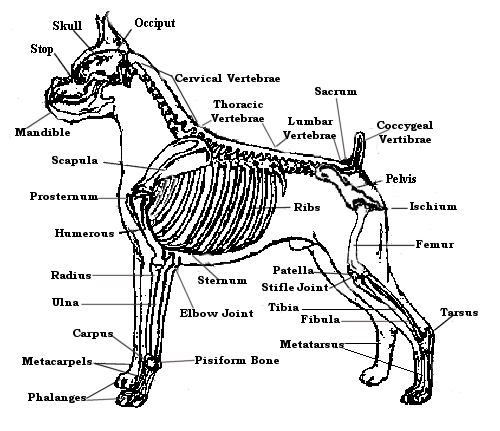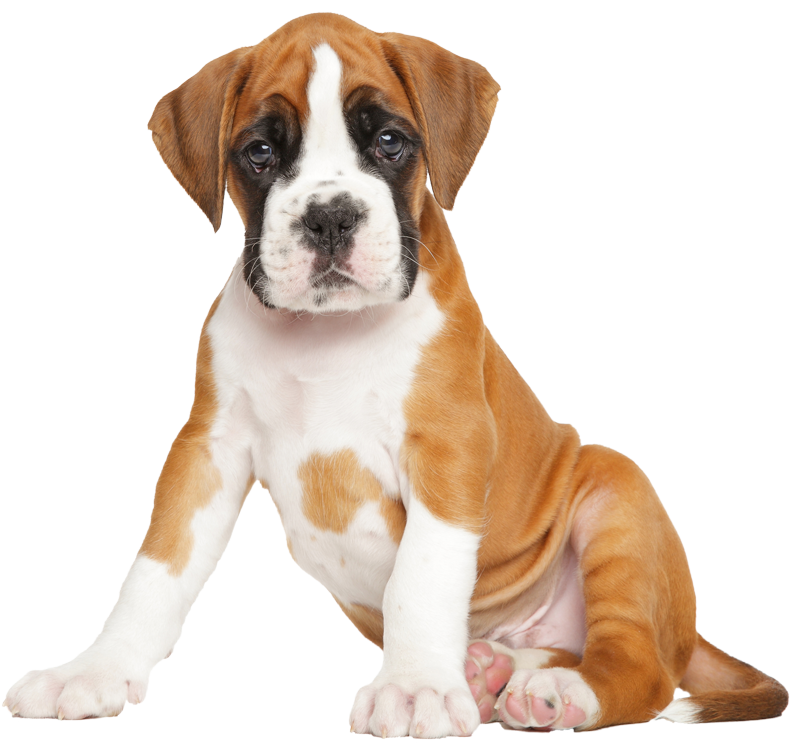
The Boxer
The Boxer is a medium sized family dog that makes a wonderful companion for children and adults alike. He is often referred to as the clown of the canine world. A happy, loyal and trustworthy breed who will protect his family with love.
The Boxer Breed Standard
The Boxer Standard is the “blueprint” which Boxer breeders strive to produce in their breeding programs.
General Appearance
The Boxer is a medium sized, sturdy, smooth-haired dog of short square figure and strong limb. The musculation is clean and powerfully developed and should stand out plastically from under the skin. As a service and guard dog he must combine a considerable degree of elegance with the substance and power essential to his duties; those of an enduring escort dog whether with horse, bicycle or carriage and as a splendid jumper. Only a body whose individual limbs are built to withstand the most strenuous “mechanical” effort and assembled as a complete and harmonious whole, can respond to such demands. Therefore to be at its highest efficiency, the Boxer must never be plump or heavy. Whilst equipped for great speed, it must not be racy. When judging the Boxer the first thing to be considered is general appearance, the relation of substance to elegance and the desired relationship of the individual parts of the body to each other. Consideration, too, must be given to colour. After these, the individual parts should be examined for their correct construction and their functions. Special attention should be devoted to the head.
Characteristics / Temperament
The character of the Boxer is of the greatest importance and demands the most careful attention. He is renowned from olden times for his great love and faithfulness to his master and household, his alertness, and fearless courage as a defender and protector. The Boxer is docile but distrustful of strangers. He is bright and friendly in play but brave and determined when roused. His intelligence and willing tractability, his modesty, and cleanliness make him a highly desirable family dog and cheerful companion. He is the soul of honesty and loyalty. He is never false or treacherous even in his old age.
Head and Skull
The head imparts to the Boxer a unique individual stamp peculiar to the breed. It must be in perfect proportion to his body; above all it must never be too light.
The muzzle is the most distinctive feature. The greatest value is to be placed on its being of correct form and in absolute proportion to the skull. The beauty of the head depends upon the harmonious proportion between the muzzle and the skull. From whatever direction the head is viewed, whether from the front, from the top or from the side, the muzzle should always appear in correct relationship to the skull. That means that the head should never appear too small or too large. The length of the muzzle to the whole of the head should be as 1 is to 3.
The head should not show deep wrinkles. Normally wrinkles will spring up on the top of the skull when the dog is alert. Folds are always indicated from the root of the nose running downwards on both sides of the muzzle. The dark mask is confined to the muzzle. It must be in distinct relief to the colour of the head so that the face will not have a “sombre” expression.
The muzzle must be powerfully developed in length, in breadth and in height. It must not be pointed or narrow, short or shallow. Its shape is influenced through the formation of both jaw-bones, the placement of teeth in the jaw-bones, and through the quality of the lips. The top of the skull should be slightly arched. It should not be so short that it is rotund, too flat, or too broad.
The occiput should not be too pronounced. The forehead should form a distinct stop with the top line of the muzzle, which should not be forced back into the forehead like that of a Bulldog. Neither should it slope away (downfaced). The tip of the nose should lie somewhat higher than the root of the muzzle.
The forehead should show a suggestion of furrow which, however, should never be too deep, especially between the eyes.
Corresponding with the powerful set of teeth, the cheeks accordingly should be well developed without protruding from the head with “too bulgy” an appearance. For preference they should taper into the muzzle in a slight, graceful curve.
The nose should be broad and black, very slightly turned up. The nostrils should be broad with a naso-labial line between them. The two jaw-bones should not terminate in a normal perpendicular level in the front but the lower jaw should protrude beyond the upper jaw and bend slightly upwards.
The Boxer is normally undershot. The upper jaw should be broad where attached to the skull, and maintain this breadth except for a very slight tapering to the front.
Eyes
The eyes should be dark brown; not too small or protruding; not deep set. They should disclose an expression of energy and intelligence, but should never appear gloomy, threatening or piercing. The eyes must have a dark rim.
Ears
Some American and Continental Boxers are cropped and are ineligible for competition under Kennel Club Regulations. The Boxer’s natural ears are defined as: moderate in size (small rather than large), thin to the touch, set on wide apart at the highest points of the sides of the skull and lying flat and close to the cheek when in repose. When the dog is alert the ears should fall forward with a definite crease.
Mouth
The canine teeth should be as widely separated as possible. The incisors (6) should all be in one row, with no projection of the middle teeth. In the upper jaw they should be slightly concave. In the lower they should be in a straight line. Both jaws should be very wide in front; bite powerful and sound, the teeth set in the most normal possible arrangement. The lips complete the formation of the muzzle. The upper lip should be thick and padded and fill out the hollow space in front formed by the projection of the lower jaw and be supported by the fangs of the jaw. These fangs must stand as far apart as possible and be of good length so that the front surface of the muzzle becomes broad and almost square; to form an obtuse (rounded) angle with the top line of the muzzle. The lower edge of the upper lip should rest on he edge of the lower lip. The repandous (bent upward) part of the under-jaw with the lower lip (sometimes called the chin) must not rise above the front of the upper lip. On the other hand, it should not disappear under it. It must, however, be plainly perceptible when viewed from the front as well as the side, without protruding and bending upward as in the English Bulldog. The teeth of the under-jaw should not be seen when the mouth is closed, neither should the tongue show when the mouth is closed.
Neck
The neck should be not too thick and short but of ample length, yet strong, round, muscular and clean-cut throughout. There should be a distinctly marked nape and an elegant arch down to the back.
Forequarters
The chest should be deep and reach down to the elbows. The depth of the chest should be half the height of the dog at the withers. The ribs should be well arched but not barrel-shaped. They should extend far to the rear. The loins should be short, close and taut and slightly tucked up. The lower stomach line should blend into an elegant curve to the rear. The shoulders should be long and sloping, close lying but not excessively covered with muscle. The upper arm should be long and form a right-angle to the shoulder-blade. The forelegs when seen from the front should be straight, parallel to each other and have strong, firmly articulated (joined) bones. The elbows should not press too closely to the chest-wall nor stand off too far from it. The underarm (forearm) should be perpendicular, long and firmly muscled. The pastern joint of the foreleg should be clearly defined, but not distended. The pastern should be short, slightly slanting and almost perpendicular to the ground.
Body
The body viewed in profile should be of square appearance. The length of the body from the front of the chest to the rear of the body should equal the height from ground to the top of the shoulder, giving the Boxer a short-coupled, square profile. The torso rests on trunk-like legs with strong bones. The withers should be clearly defined. The whole back should be short, straight, broad and very muscular.
Hindquarters
The hindquarters should be strongly muscled. The musculation should be hard and stand out plastically through the skin. The thighs should not be narrow and flat but broad and curved. The breech musculation should also be strongly developed. The croup should be slightly sloped, flat arched and broad. The pelvis should be long and, in females especially, broad. The upper and lower thighs should be long. The hip and knee (stifle) joints should have as much angle as possible. In a standing position the knee (stifle) should reach so far forward that it would meet a vertical line drawn from the hip protuberance to the floor. The hock angle should be about 140 degrees; the lower part of the foot at a slight slope of about 95 to 100 degrees from the hock joint to the floor; that is, not completely vertical. Seen from behind the hindlegs should be straight. The hocks should be clean and not distended, supported by powerful rear pads.
Feet
The feet should be small with tightly-arched toes (cat-feet) and hard soles. The rear toes should be just a little longer than the front toes, but similar in all other respects.
Tail
The tail attachment should be high. The tail should be preferably docked and carried upwards and should, preferably, be not more than 5 cm (2 ins) long.
Gait/Movement
Movement of the Boxer should be alive with energy. His gait, although firm, is elastic. The stride free and roomy; carriage proud and noble.
Coat
The coat should be short and shiny, lying smooth and tight to the body.
Colour
The permissible colours are fawn, brindle and fawn in various shades from light yellow to dark deer red. The brindle variety should have black stripes on a golden-yellow or red-brown background. The stripes should be clearly defined and above all should not be grey or dirty. Stripes that do not cover the whole top of the body are not desirable. White markings are not undesirable, in fact, they are often very attractive in appearance. The black mask is essential but when white stretches over the muzzle, naturally that portion of the black mask disappears. It is not possible to get black toe-nails with white feet. It is desirable, however, to have an even distribution of head markings.
Size
Dogs: 56-61 cm (22-24 ins) at the withers.
Bitches: 53-58.5 cm (21-23 ins) at the withers.
Heights above or below these figures not to be encouraged.
Dogs around 58.5 cm (23 ins) should weigh about 30 kg (66 lbs) and
Bitches of about 56 cm (22 ins) should weigh about 28 kg (62 lbs).
Faults
Temperament: Viciousness ; treachery; unreliability; lack of temperament; cowardice.
Head: A head that is not typical. A plump, bulldoggy appearance. Pinscher or Bulldog head.
Appearance: Light bone. Lack of proportion. Bad physical condition. Lack of nobility and expression. “Sombre” face.
Bite: Unserviceable bite whether due to disease or to faulty tooth placement. Showing the teeth or the tongue. A sloping top-line of the muzzle. Too pointed or too light a bite (snipy).
Eyes: Visible conjunctiva (haw). Light eyes.
Ears: Flying ears; rose ears; semi-erect or erect ears.
Neck: Dewlap.
Front: Too broad and low in front; loose shoulders; chest hanging between the shoulders; hare feet; turned legs and toes.
Body: Carp (roach) back; sway back; thin, lean back; long, narrow, sharp-sunken in loins. Weak union with the croup, hollow flanks; hanging stomach.
Hindquarters: A falling off or too arched or narrow croup.
A low-set tail; higher in back than in front; steep, stiff or too little angulation of the hindquarters; light thighs; cow-hocks; bow-legs; hind dew-claws; soft hocks, narrow heel, tottering, waddling gait; hare’s feet; hindquarters too far under or too far behind.
Colour: Boxers with white or black ground colour, or entirely white or black or any other colour than fawn or brindle.
(White markings are allowed but must not exceed one third (1/3) of the ground colour.)
NOTE: Male animals should have two apparently normal testicles fully descended into the scrotum.
He is an active dog and can be strong-willed and become unruly if not provided with training and boundaries particularly for the first year of his life. If you don’t have the time to train your Boxer then do not get one!
The Boxer will enthusiastically welcome most people you invite into your home but can be very reserved if he feels distrustful of certain individuals. Therefore he will make an excellent watch dog, his looks and barking will scare off any intruder, although little do they know that he is really a big softy at heart.
He can be stubborn and aggravating then turn around and delight and entertain you with his playful antics and exuberance for life. He will play gently with young children, rough-house teenagers and make the perfect companion around the house or garden with adults. You can hurt his feelings easily by the tone of your voice or by ignoring him. Love him and your love will be returned ten fold. Anyone who does not love a BOXER does not know a BOXER.
The BOXER is definitely NOT an outdoor breed! Yes they love outside activities, long walks, camping, runs along the beach but if he will not be allowed to live in the house as part of your family you would be better to choose another more independent breed! The Boxer must be protected from the elements, whether that be the cold of winter or the heat of summer with their short coat offering little protection from the elements. Besides, they would be broken hearted if they couldn’t be with their people – sharing the sofa or lying at your feet as you all watch TV in the evening.
A Boxer that cannot join his family inside their home will become destructive and anxious. If you are not prepared to welcome your Boxer into your home … choose another breed!
Boxer Health Issues
Health Issues
All purebred dogs have known health issues. Dogs that are not purebred have health issues too. You just don’t know which ones they will have!
Boxers have a relatively short life span of between 9 and 12 years, although many do live longer. It is important to remember that not all Boxers will fall victim to the known health issues, many will live a healthy, disease free life reaching a grand age.
Responsible, registered breeders health screen their breeding animals against the most common diseases, where testing is available, to reduce the risk of genetic disorders. Deciding to purchase your puppy from a registered breeder is a wise first decision on the path to dog ownership.
The most prevalent health problems in Boxers are Heart Disease (Stenosis, Cardiomyopathy and Heart murmurs); Degenerative Myelopathy; Skin cancers; Hip Displasia; Juvenile Kidney Disease (JKD); and Hyperthyroidism.
Heart Disease
Stenosis and Cardiomyopathy are inherited diseases of the heart. Stenosis can be detected by stethoscope. For Cardiomyopathy there is a test for dogs and bitches over 2 years of age. Knowledgeable breeders test their breeding stock and know which dogs have been affected by this disease, and they do not use them in their breeding program.
Heart murmurs can be detected early in puppies and as reputable breeders test all their breeding stock it is not a common occurrence nowadays. If a puppy is detected to have a murmur, breeders do NOT sell these to pet homes but run them on themselves to see if the puppy improves with age or the condition worsens.
The Boxer Association of Victoria facilitates a Heart Health Screening Program where dogs are assessed and scored by veterinarians. The Program details and database of results can be viewed here.
Arrhythmogenic Right Ventricular Cardiomyopathy (ARVC) is a familial cardiac disease characterised by ventricular arrhythmias and sudden cardiac death. DNA testing is available that can indicate if a Boxer is clear of the identified gene, carries the gene or is positive (at risk of developing ARVC).
Please note that environmental factors and other diseases can also contribute to heart disease in dogs.
Degenerative Myelopathy (DM)
Degenerative Myelopathy in Boxer dogs is a neurological condition similar to Lou Gehrig’s disease in people. The condition typically begins with rear end weakness but, over time, develops into full paralysis. The condition usually does not appear until the dog reaches maturity or in old age.
There is currently no effective treatment or cure, however there is a genetic test that can be done that identifies if a dog is clear of the gene, a carrier, or positive (at risk of developing the disease).
Reputable breeders conduct DNA testing of their breeding stock prior to mating to ensure they do not mate a Boxer that may be a carrier to a Boxer that is also a carrier thereby running the risk of producing puppies that have the condition.
Boxers that are positive for DM are not bred with.
Cancer
Skin cancers are quite common in Boxers. Usually, they can be removed easily with no effect on a dog’s health. Cancer itself can be found in Boxers but no more than most other breeds. Cancer is believed to have a hereditary factor but there is no genetic test available to rule out an animal’s predisposition to cancer.
Hip Displasia
Hip Displasia is a disease with a genetic factor and results in a hip joint that is too shallow for the ball of the joint to fit correctly. This can be a debilitating disease, depending on the severity. It is rare in Boxers from show lines, but it does occur more commonly in the general Boxer population.
Juvenile Kidney Disease (JKD)
Juvenile Kidney Disease (JKD) has been diagnosed in Boxer populations in the UK and USA. While it has not been considered and issue in Australia many breeders will perform a simple SDMA blood test on breeding stock. The SDMA test can detect early indicators of kidney disease or loss of kidney function.
Hypothyroidism
Hypothyroidism is found in Boxers, but it is not a common problem and is often triggered by external conditions rather than inherited.
Puppy Checklist
The Boxer Association of Victoria has created a simple check list to help you on your way to welcoming a beautiful Boxer puppy into your family.
View the Checklist
- The parents of puppies offered for sale should have been heart checked and tested heart murmur free in compliance with the Boxer Association Heart Scheme Program.
- The puppies should look plump and healthy, with loose pliable skin, clear eyes, loose coat (pull up the skin on the pups back to see if it very loose).
- Healthy pups at around 6-8 weeks should have a ‘toasty’ smell and fresh breath.
- The environment where puppies are a kept is clean and comfortable.
- The mother has a very good temperament, playful and gay, not shy or aggressive and looks in good condition (Bare in mind she may be a little thin and her coat may be sparse as she has just gone through feeding and rearing this litter).
- Check that your puppy of choice will come to you when called, and is outgoing, friendly and playful (when fully awake as pups can be drowsy if just awakened) and is not timid or cower in a corner.
- All puppies must have been vet checked and received their first vaccination, and not leave their mother for their new home before a minimum of 8 WEEKS of age.
- A pup that leaves earlier has not had time to fully socialise with its siblings and develop a pack instinct, and may become dog aggressive as it grows.
- When you come to collect your pup you should receive a Puppy Packet which contains;
- DIET SHEET – it is most important for the welfare of your pup that he has the correct diet to help him grow and stay healthy for life.
- ADVICE SHEET on how to care for your pup when you get home including correct housing, worming program, training. PEDIGREE
- REGISTRATION PAPERS either Full registration if you are showing and/or breeding, or Limited Registration if you are wanting a pet only (Obedience and Agility dogs only need Limited Registration papers) signed and dated on the reverse.
- MEMBERSHIP APPLICATION FORMS Boxer Association of Victoria and DOGS VICTORIA
- CERTIFICATE OF INOCULATION and date when next inoculation is due
- CONTACT NUMBERS for the breeder, their Veterinary surgery and Dogs Victoria
- GUARANTEE of continued service to you and your pup.
- DIET SAMPLE a day or two sample of what your puppy is currently eating so that you can gradually wean him to your planned diet if different from his current diet
Registered Breeders
The following Members have chosen to advertise on the Club Web site for a small fee. Should you wish further information in relation to any of these members, please contact them directly.
Registered Breeders
Lambda Boxers
Lionel Bleakly & Arthur Fry
03 9740 8788
lambdaboxers.com
Kesdar Boxers
Helen Keele & Jen Davis
0407 306 618
kesdarboxers.com
Litter Service
Contact our Litter service for an up-to-date list of members who have a current litter of puppies. Inclusion on the litter service does not mean the BAOV endorses the breeder or puppy.
Call the Litter Service
TOPOGRAPHICAL ANATOMY
Boxer Breed Standard – Australia
Original drawing adapted from the JKC Illustrated Breed Standards
1. Nape of neck
2. Crest of neck
3. Tailset
4. Long Pelvis
5. Body behind the tail
6. Breech width- well developed
7. Well developed muscles
8. Hock (140o angle)
9. Rear pastern – not vertical
10. Second (lower) thigh – broad
11. Stifle joint
12. First (Upper) thigh – broad
13. End of ribcage – well ribbed back
14. Graceful curve of underline
15. Lowest point of ribcage
16. Stopper pad
17. Cat feet
18. Slightly sloping pasterns
19. Upper Arm
20. Forechest or breastbone
21. Shoulderblade – 45 degrees
22. Clean (dry) neck
23. Flews
24. Chin – repandous
25. Muzzle – Powerfully developed in length, breadth and height
26. The front surface of the muzzle forms an obtuse (rounded) angle with the topline of the muzzle
27. The upper lip should be thick and padded and fill out the hollow space in front formed by the projection of the lower jaw.
28. Nose – broad and black and very slightly turned up
29. Stop – Distinct
30. Top of skull – slightly arched
Unbroken Red coloured lines represents the forequarter, hindquarter and pelvic angulation of the dog.
Red lines A represent the SHOULDER ANGULATION. The shoulder should be long and sloping, close lying but not excessibely covered in muscle. The upper arm should be long and form a right angle with the shoulder blade.
Red lines B represent the HIND ANGULATION. The hip and knee(stifle) should have as much angle as possible. The hock angle should be about 140 degrees. The lower part of the foot at a slight slope of about 95 to 100 degrees to the floor, that is, not completly vertical.
Green lines C should be equal in length. Top of shoulder to brisket = brisket to ground.
Blue lines D should be equal in length. Front of chest to rear of body = top of shoulder to ground.
The broken yellow line – Ribage extending far to the rear giving a short loin area.
Withers – clearly defined
Back – short,straight, broad and very muscular
Loin – short, close taut and slightly tucked up
Croup – slightly sloped, flat arched and broad.

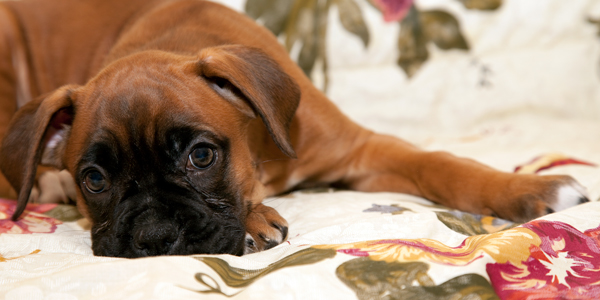
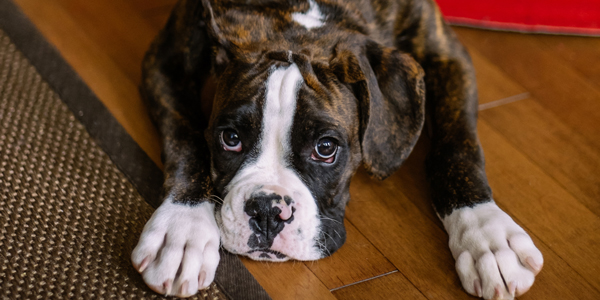

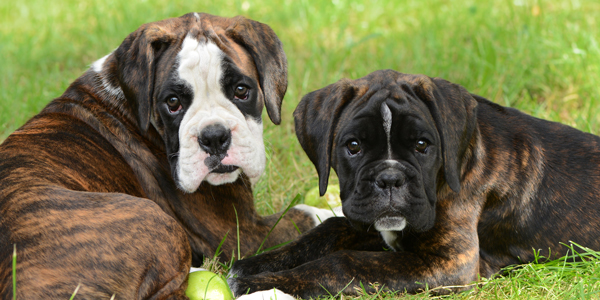
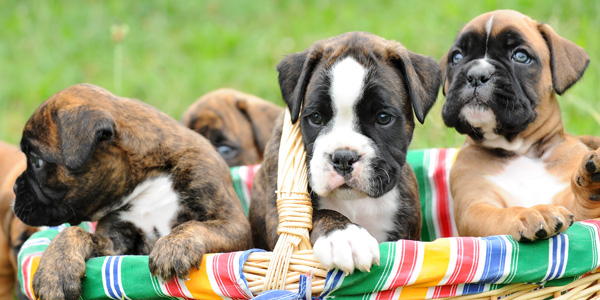
Contact the BAOV
Main Contacts
Secretary 0427 242 883
President 0438 771 877
Litter Service 0407 306 618
Email enquiries
Or send a message via the form on the right.
We will get back to you as soon as possible.
